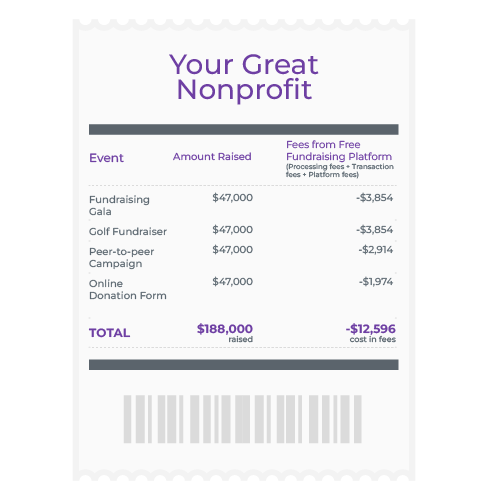May 22, 2025
Tipping the Scales: Revealing the Impact of Fundraising Platform Tipping on Transparency and Donor Trust

Let’s talk tipping. Do you find yourself tipping more nowadays than ever before? From the dry cleaners to the florist to the local coffee shop, digital tipping is on the rise. But what about tipping on a free fundraising platform? Online fundraising platforms offer a valuable way for nonprofits to raise funds, with a few providing free fundraising technology. However, these free platforms often use a unique revenue model that relies on donors tipping the fundraising platform. While this approach allows platforms to operate without direct fees to nonprofits, it also has implications for donors and their overall experience. Read on to learn how tipping can impact nonprofits and donors, the potential lack of transparency, and its influence on donation decisions
What is the Donor Tipping Model?
During the donation process, the platform may ask the donor if they want to add a tip. The tipping usually covers the platform fee. Additional fees are also incurred to cover the processing and transaction fees. Free fundraising platforms usually default the tip amount to anywhere between 10-19% of the total donation. If an organization turns off the tipping option, they will incur a platform fee.
How Tipping on Free Fundraising Platforms Affects Nonprofits and Donors
With donor retention rates down, the donor experience is more important than ever before. Tipping fatigue remains a battle for all industries. For fundraising platforms, tipping can have a negative impact on the donor at a crucial time; they’ve heard your stories and impact and are now making the decision to provide financial support. Encountering an unexpected fee during the donation process may change your donor’s mind.
Perceived Lack of Transparency
When tipping is defaulted at a high rate, like 10-19%, donors may feel like the platform is attempting to take advantage of their goodwill, especially if the tipping option isn’t immediately obvious or easy to adjust. The nonprofits that choose to use these platforms risk being associated with a lack of transparency, as donors may question how much of their donation is going to the intended cause versus covering platform costs. If donors are unaware that a portion of their donation goes to platform costs through tipping, they may feel misled once they realize it. As a result, this can lead to a decrease in trust, both towards the platform and the nonprofit. Instead, platforms should clearly communicate why the tipping system exists, and offer donors an easy way to opt out or adjust the tip percentage.
Impact on Donation Decisions
High default tip percentages can discourage donations or lead donors to reduce their donation amounts, especially if they perceive the tipping as excessive or mandatory. Nonprofits could lose out on potential donations if donors are put off by these practices.
Extra Work for Nonprofits
Navigating the tipping landscape on free fundraising platforms can be challenging for nonprofits. Although tipping can help sustain these platforms, it often leads to confusion or friction among donors who may not want to pay more than they planned. To mitigate this, some nonprofits are proactively clarifying tipping policies and guiding donor behavior to align with their goals and the interests of their supporters. This creates more work for the nonprofit that could have been spent on their actual mission.
Here’s an example of how one nonprofit has navigated around tipping:

Donor Reactions to Tipping on Free Fundraising Platforms
While the donor tipping model is attractive for nonprofits seeking to minimize overhead, it introduces a potential complication: how donors perceive these tipping requests.
Based on anecdotal evidence, here’s an expansion on the potential impact of tipping on nonprofit donations.
Donor Confusion
Donors might be surprised by the request to tip a fundraising platform. When they donate to a nonprofit, they generally expect their entire contribution to go toward the cause they support. A request for an additional tip might cause confusion or dissatisfaction.
Transparency Issues
When donors are asked to tip without a clear explanation of how the tipping system works or where the tip money goes, it might raise concerns about transparency. Lack of transparency can erode trust in both the platform and the nonprofit, ultimately affecting donor retention and future contributions. For example, we found the following real experiences from nonprofits:
- “Sometimes it’s confusing for our users about what [free fundraising platform] calls their tip. Users aren’t sure if that’s going to us (a nonprofit).”
- “Didn’t like the automatic tipping set at either 12-15% of purchase. Some guests didn’t realize this was happening until after they purchased. I think the option to tip [free fundraising platform] is great but that it shouldn’t be already set at a certain percentage. Set it at zero with the option of the customer to choose to tip. Some guest felt they were swindled into the tip.“
- “Additionally, the “Tipping” function can be frustrating. Many donors have thought they were covering the processing fee, but they were actually “tipping” [free fundraising platform]. We shut that functionality off and pay the associated fees so our donors don’t have to deal with that. We think it feels wrong to donors when they give $1000 and then are asked to add a $100 “tip” to [free fundraising platform]. We do ask donors to cover processing fees, and most are happy to do so.”
- “We also did not like the Tips feature, which if activated removed their platform fees. Essentially, if you leave the Tip feature on then at checkout it provides the donor with the option to also tip [free fundraising platform]. We felt that this was confusing to our donors, who may not understand what [free fundraising platform] is, and that those funds would not be included as part of their gift to our organization. We would instead prefer to have a flat platform fee, but realize this probably means they would make less money.”
Are Free Fundraising Platforms Worth the Donor Abrasion?
When nonprofits ask donors to tip the fundraising platform to cover their costs it can cause confusion and frustration amongst donors. We did the math, and if a nonprofit were to turn off the donor tipping on the free fundraising platform to avoid donor abrasion, here’s how much they would pay the “free” fundraising platform per campaign.
According to our internal data, on average, nonprofits run four fundraising activities per year, each raising approximately $47,000. If these nonprofits opt for a free platform but disable tipping to avoid donor confusion, they face an extra charge of 1-5% per campaign plus processing and transaction fees.

The $12,596 in fees is almost 30% MORE than the cost of using GiveSmart for the same activities. Plus, with GiveSmart, you receive top-rated technology with unlimited use for one annual subscription fee, and no additional charge for ticketing or transaction fees like you’ll experience with many free fundraising platforms.
Maximize Your Impact with GiveSmart
As you can see, using a free platform with tipping options may cause more harm than good. Instead, partner with a long-standing, reputable fundraising technology partner that instills donor trust, like GiveSmart. GiveSmart is the only top-rated all-in-one fundraising, event management, and donor management platform you’ll ever need to maximize your mission impact.
Related



